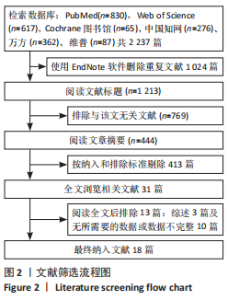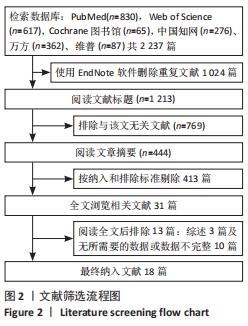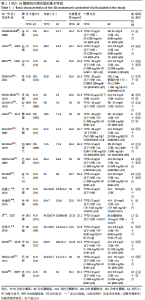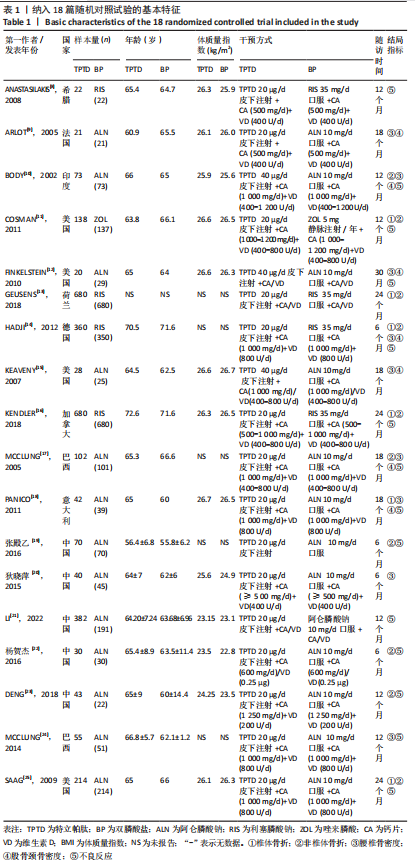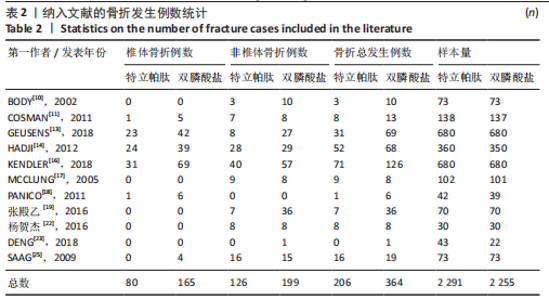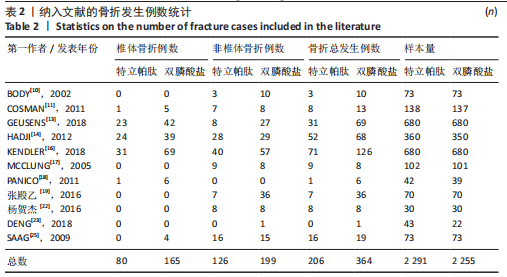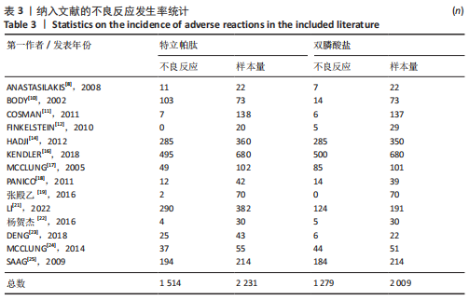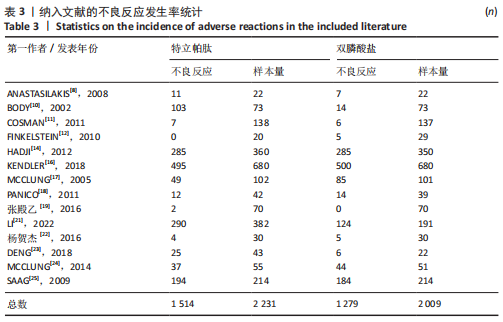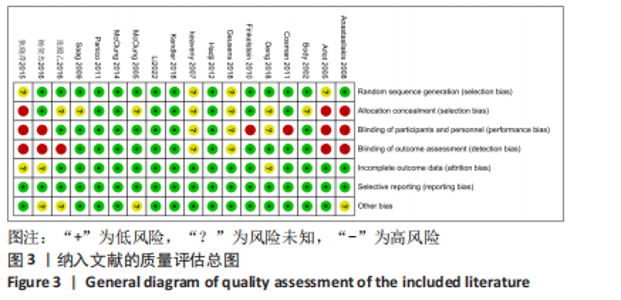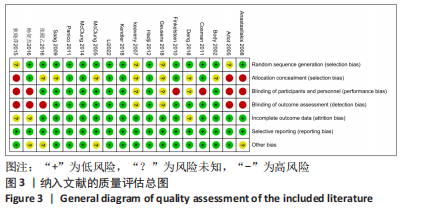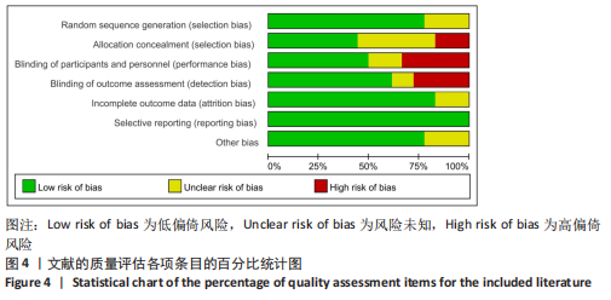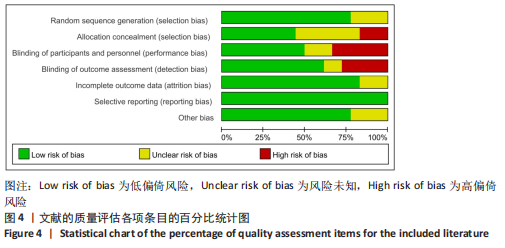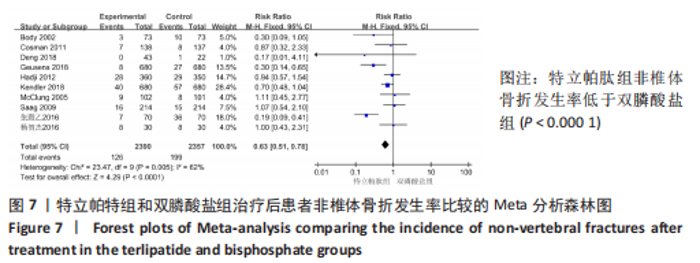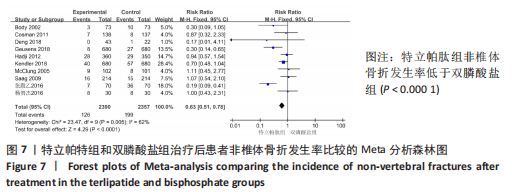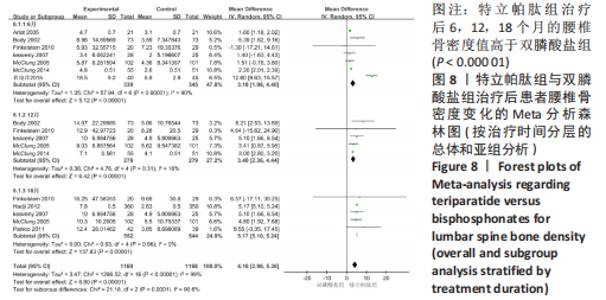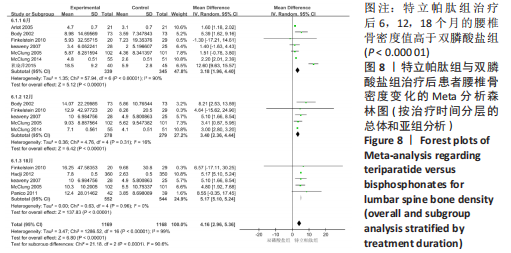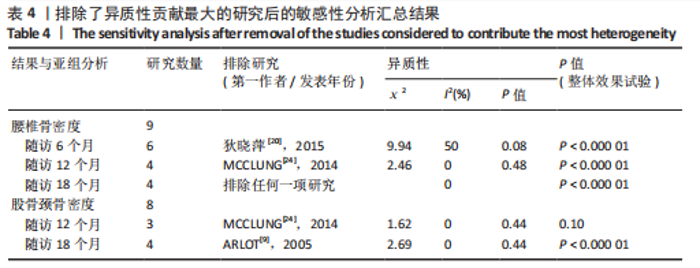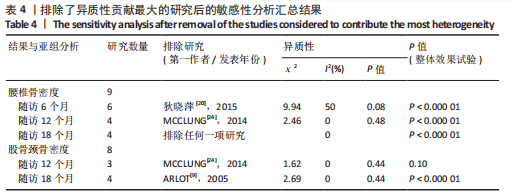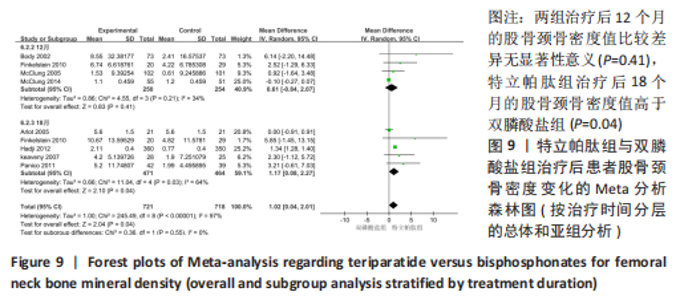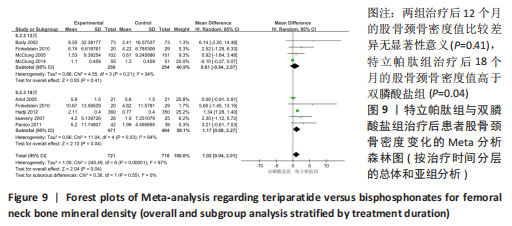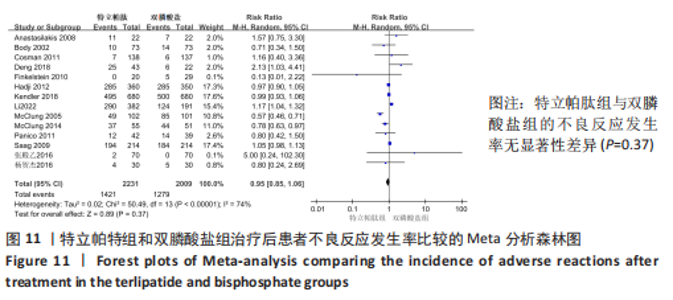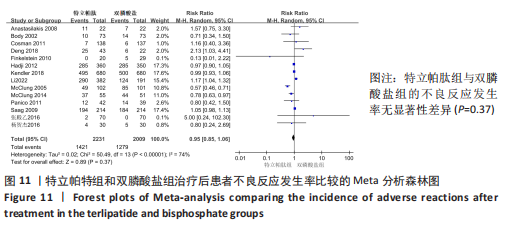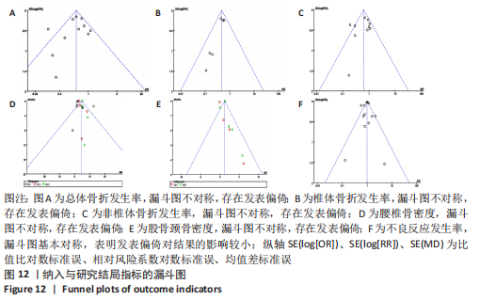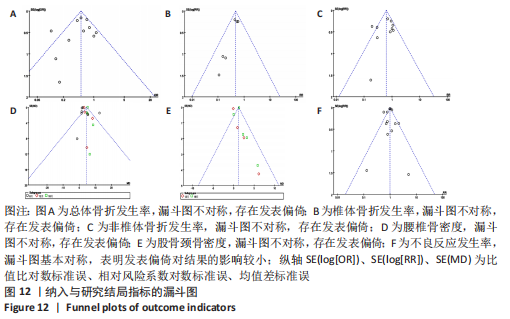Chinese Journal of Tissue Engineering Research ›› 2024, Vol. 28 ›› Issue (4): 639-645.doi: 10.12307/2024.963
Previous Articles Next Articles
Meta-analysis of efficacy and safety of terlipatide and bisphosphate in the treatment of postmenopausal osteoporosis fractures
Abuduwupuer·Haibier1, 2, Alimujiang·Yusufu1, 2, Maihemuti·Yakufu1, 2, Maimaitimin·Abulimiti1, 2, Tuerhongjiang·Abudurexiti1, 2
- 1Xinjiang Medical University, Urumqi 830054, Xinjiang Uygur Autonomous Region, China; 2The Sixth Affiliated Hospital of Xinjiang Medical University, Urumqi 830002, Xinjiang Uygur Autonomous Region, China
-
Received:2022-12-06Accepted:2023-01-11Online:2024-02-08Published:2023-07-14 -
Contact:Tuerhongjiang·Abudurexiti, Master, Chief physician, Master’s supervisor, Xinjiang Medical University, Urumqi 830054, Xinjiang Uygur Autonomous Region, China; The Sixth Affiliated Hospital of Xinjiang Medical University, Urumqi 830002, Xinjiang Uygur Autonomous Region, China -
About author:Abuduwupuer·Haibier, Master candidate, Xinjiang Medical University, Urumqi 830054, Xinjiang Uygur Autonomous Region, China; The Sixth Affiliated Hospital of Xinjiang Medical University, Urumqi 830002, Xinjiang Uygur Autonomous Region, China
CLC Number:
Cite this article
Abuduwupuer·Haibier, Alimujiang·Yusufu, Maihemuti·Yakufu, Maimaitimin·Abulimiti, Tuerhongjiang·Abudurexiti. Meta-analysis of efficacy and safety of terlipatide and bisphosphate in the treatment of postmenopausal osteoporosis fractures[J]. Chinese Journal of Tissue Engineering Research, 2024, 28(4): 639-645.
share this article
Add to citation manager EndNote|Reference Manager|ProCite|BibTeX|RefWorks
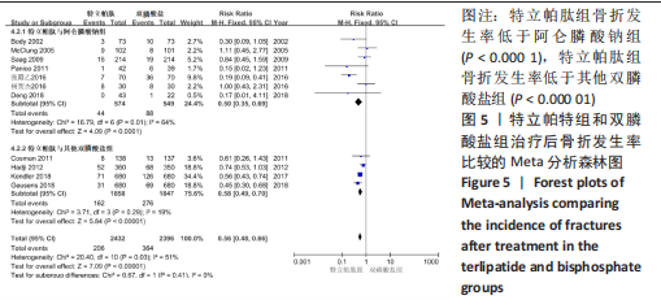
2.4 Meta分析结果 2.4.1 各组治疗后骨折发生率差异 共11项随机对照试验报告了使用双膦酸盐或特立帕肽治疗后的骨折发生率[10-11,13-14,16-19,22-23,25]。接受特立帕肽治疗的绝经后骨质疏松患者与接受双膦酸盐治疗的患者之间的骨折发生率有显著差异(RR=0.56,95%CI:0.48-0.66,P < 0.000 01);特立帕肽组的结果明显优于双膦酸盐组。各试验之间有明显异质性(P=0.03,I2=51%)。按药物类型分层亚组分析显示:特立帕肽在预防绝经后骨质疏松症妇女骨折方面优于阿仑膦酸钠(RR=0.50,95%CI:0.35-0.69,P < 0.000 1)。特立帕肽在预防绝经后骨质疏松妇女骨折方面优于其他双膦酸盐(RR=0.58,95%CI:0.49-0.70,P < 0.000 01)。各亚组间统计学异质性较小(P=0.29,I2=19%),临床异质性可以接受,见图5。"
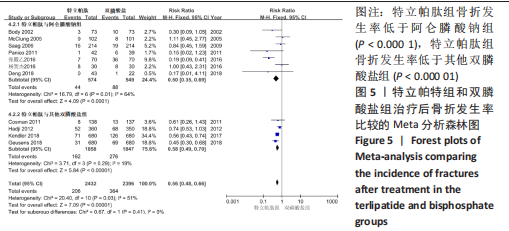
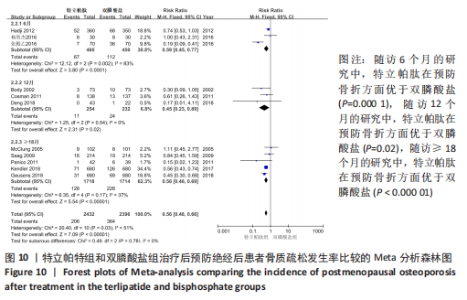
2.4.6 按随访时间进行亚组分析 共3项随机对照试验的随访时间为6个月[14,19,22],3项随机对照试验的随访时间为12个月[10-11,23],5项随机对照试验的随访时间≥18个月[13,16-18,25]。根据随访时间的差异进行亚组分析:在随访6个月的研究中,特立帕肽组和双膦酸盐组之间异质性偏高(P=0.002,I2=87%);随访12个月的研究中,两组之间无统计学异质性(P=0.54,I2=0%),特立帕肽在预防绝经后骨质疏松妇女骨折方面优于双膦酸盐(RR=0.45,95%CI:0.23-0.89,P=0.02);随访时间超过18个月的研究中,两组之间统计学异质性较小(P=0.003,I2=37%),临床异质性可以接受,采用固定效应模式进行Meta分析,(RR=0.56,95%CI:0.48-0.69,P < 0.000 01),随访≥18个月,特立帕肽在预防绝经后骨质疏松妇女骨折方面优于双膦酸盐,见图10。"
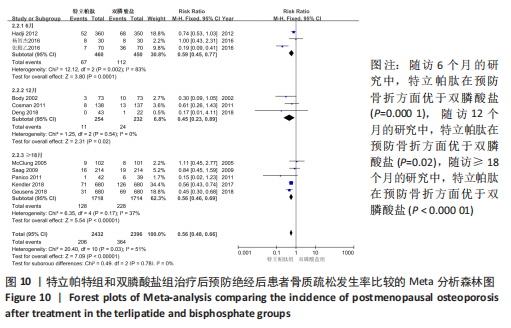

2.4.9 敏感性分析结果 为了确认文章的结果是可靠的,通过对随访时间的长短进行敏感性亚组分析寻找异质性来源,对腰椎骨密度(6,12,18 个月)和股骨颈骨密度(12,18个月)两项结局指标进行敏感性分析。结果显示,对于腰椎骨密度随访6个月,剔除狄晓萍等[20]的文献后效应量发生方向性改变(P > 0.05),其他任一文献未对总效应量大小造成显著性影响,提示狄晓萍等[20]的文献可能是异质性来源;对于腰椎骨密度随访12个月和18个月,逐一剔除单个研究并未对结果产生影响,提示各结局指标结论稳定可靠,具体情况见表4。通过逐篇剔除股骨颈骨密度随访18个月所纳入的文献,结果显示,股骨颈骨密度的异质性主要来源于ARLOT等[9],剔除该文献后,各研究间异质性降低(I2=0%,P < 0.000 01);而逐一剔除股骨颈骨密度随访12个月所纳入的文献,发现股骨颈骨密度的异质性主要来自MCCLUNG等[24]的研究,剔除该文献后,各研究间异质性降低且效应量发生方向性改变(I2=0%,P=0.10),具体情况见表4。"

| [1] 马远征,王以朋,刘强,等.中国老年骨质疏松症诊疗指南(2018)[J].中国骨质疏松杂志,2018, 24(12):1541-1567. [2] HADJI P, JACOB L, KOSTEV K. Gender- and age-related treatment compliance in patients with osteoporosis in Germany. Patient Prefer Adher. 2016;10:2379-2385. [3] SI L, WINZENBERG TM, JIANG Q, et al. Projection of osteoporosis-related fractures and costs in China: 2010-2050. Osteoporos Int. 2015;26(7):1929-1937. [4] 夏维波,章振林,林华,等.原发性骨质疏松症诊疗指南(2017)[J].中国骨质疏松杂志,2019, 25(3):281-309. [5] MCCONNELL M, SHIEH A. Polypharmacy in osteoporosis treatment. Clin Geriatr Med. 2022;38(4):715-726. [6] CHANG B, QUAN Q, LI Y, et al. Treatment of osteoporosis, with a focus on 2 monoclonal antibodies. Med Sci Monit. 2018;24:8758-8766. [7] COLLINGE C, FAVELA J. Use of teriparatide in osteoporotic fracture patients. Injury. 2016;47: S36-S38. [8] ANASTASILAKIS AD, GOULIS DG, POLYZOS SA, et al. Head-to-head comparison of risedronate vs. teriparatide on bone turnover markers in women with postmenopausal osteoporosis: a randomised trial. Int J Clin Pract. 2008;62(6):919-924. [9] ARLOT M, MEUNIER PJ, BOIVIN G, et al. Differential effects of teriparatide and alendronate on bone remodeling in postmenopausal women assessed by histomorphometric parameters. J Bone Miner Res. 2005;20(7):1244-1253. [10] BODY JJ, GAICH GA, SCHEELE WH, et al. A Randomized double-blind trial to compare the efficacy of teriparatide [recombinant human parathyroid hormone (1-34)] with alendronate in postmenopausal women with osteoporosis. J Clin Endocrinol Metab. 2002;87(10):4528-4535. [11) COSMAN F, ERIKSEN EF, RECKNOR C, et al. Effects of intravenous zoledronic acid plus subcutaneous teriparatide [rhPTH(1-34)] in postmenopausal osteoporosis. J Bone Miner Res. 2011;26(3):503-511. [12] FINKELSTEIN JS, WYLAND JJ, LEE H, et al. Effects of teriparatide,alendronate, or both in women with postmenopausal osteoporosis. J Clin Endocrinol Metab. 2010;95(4):1838-1845. [13] GEUSENS P, MARIN F, KENDLER DL, et al. Effects of teriparatide compared with risedronate on the risk of fractures in subgroups of postmenopausal women with severe osteoporosis: the VERO trial. J Bone Miner Res. 2018;33(5):783-794. [14] HADJI P, ZANCHETTA JR, RUSSO L, et al. The effect of teriparatide compared with risedronate on reduction of back pain in postmenopausal women with osteoporotic vertebral fractures. Osteoporos Int. 2012;23(8):2141-2150. [15] KEAVENY TM, DONLEY DW, HOFFMANN PF, et al. Effects of teriparatide and alendronate on vertebral strength as assessed by finite element modeling of QCT scans in women with osteoporosis. J Bone Miner Res. 2007;22(1):149-157. [16] KENDLER DL, MARIN F, ZERBINI C AF, et al. Effects of teriparatide and risedronate on new fractures in post-menopausal women with severe osteoporosis (VERO): a multicentre, double-blind, double-dummy,randomised controlled trial. Lancet. 2018; 391(10117):230-240. [17] MCCLUNG MR, SAN MARTIN J, MILLER PD, et al. Opposite bone remodeling effects of teriparatide and alendronate in increasing bone mass. Arch Intern Med. 2005;165(15):1762-1768. [18] PANICO A, LUPOLI GA, MARCIELLO F, et al. Teriparatide vs. Alendronate as a treatment for osteoporosis: changes in biochemical markers of bone turnover, BMD and quality of life. Med Sci Monit. 2011;17(8):CR442-CR448. [19] 张殿乙,李雅男,张楠,等.特立帕肽联合阿仑膦酸钠治疗绝经后骨质疏松症的临床研究[J].现代药物与临床,2016,31(8):1231-1235. [20] 狄晓萍,狄维鹏,任婷,等.特立帕肽与阿仑膦酸钠对绝经后骨质疏松患者的疗效对比[J].宁夏医学杂志,2015,37(7):648-650. [21) LI M, ZHANG Z, XUE Q, et al. Efficacy of generic teriparatide and alendronate in Chinese postmenopausal women with osteoporosis: a prospective study. Arch Osteoporos. 2022;17(1):103. [22] 杨贺杰,周辉,施建勤,等.特立帕肽与阿仑膦酸钠治疗绝经后骨质疏松症的效果比较[J].浙江临床医学,2016,18(5):912-913. [23] DENG J, FENG ZP, LI Y, et al. Efficacy and safety of recombinant human parathyroid hormone (1-34) are similar to those of alendronate in the treatment of postmenopausal osteoporosis. Medicine. 2018; 97(47):e13341. [24] MCCLUNG MR, GRAUER A, BOONEN S, et al. Romosozumab in postmenopausal women with low bone mineral density. N Engl J Med. 2014;370(5):412-220. [25] SAAG KG, ZANCHETTA JR, DEVOGELAER JP, et al. Effects of teriparatide versus alendronate for treating glucocorticoid-induced osteoporosis thirty-six-month results of a randomized,double-blind,controlled trial. Arthritis Rheum. 2009; 60(11):3346-3355. [26] CAMACHO PM, PETAK SM, BINKLEY N, et al. American association of clinical endocrinologists/american college of endocrinology clinical practice guidelines for the diagnosis and treatment of postmenopausal osteoporosis-2020 update. Endocr Pract. 2020; 26(Suppl 1):1-46. [27] 季逸超,张林林,杨惠林,等.特立帕肽与唑来膦酸治疗绝经后骨质疏松性椎体骨折的疗效对比研究[J].中华骨与关节外科杂志,2021, 14(12):1011-1015. [28] TAKADA J, DINAVAHI R, MIYAUCHI A, et al. Relationship between P1NP, a biochemical marker of bone turnover, and bone mineral density in patients transitioned from alendronate to romosozumab or teriparatide: a post hoc analysis of the STRUCTURE trial. J Bone Miner Metab. 2020;38(3):310-315. [29] MCCARTHY J, DAVIS A. Diagnosis and management of vertebral compression fractures. Am Fam Physician. 2016,94(1):44-50. [30] YOLCU Y,ALVI M,WANDERMAN N, et al. Effect of teriparatide use on bone mineral density and spinal fusion: a narrative review of animal models. Int J Neurosci. 2019;129(8):814-820. [31) CHEN Q,GUO M,MA X M, et al. Adherence to teriparatide treatment and risk of fracture: a systematic review and meta-analysis. Horm Metab Res. 2019;51(12):785-791. [32] SATO C, MIYAKOSHI N, KASUKAWA Y, et al. Teriparatide and exercise improve bone,skeletal muscle,and fat parameters in ovariectomized and tail-suspended rats. J Bone Miner Metab. 2021;39(3):385-395. [33] LANGDAHL BL, SILVERMAN S, FUJIWARA S, et al. Real-world effectiveness of teriparatide on fracture reduction in patients with osteoporosis and comorbidities or risk factors for fractures:Integrated analysis of 4 prospective observational studies. Bone. 2018;116:58-66. [34] 包呼和,孙官文,王剑,等.特立帕肽和双膦酸盐序贯治疗高龄骨质疏松症患者的疗效观察[J].实用临床医药杂志,2021,25(16):95-98. [35] MIYAUCHI A, MATSUMOTO T, SUGIMOTO T, et al. Effects of teriparatide on bone mineral density and bone turnover markers in Japanese subjects with osteoporosis at high risk of fracture in a 24-month clinical study: 12-month, randomized, placebo-controlled, double-blind and 12-month open-label phases. Bone. 2010;47(3):493-502. [36] COHEN A, SHIAU S, NAIR N, et al. Effect of teriparatide on bone remodeling and density in premenopausal idiopathic osteoporosis: a phase II trial. J Clin Endocrinol Metab. 2020;105(10):e3540-e3556. [37] HASSAN N, GREGSON CL, TOBIAS JH. Anabolic treatments for osteoporosis in postmenopausal women. Fac Rev. 2021;10:44. [38] DIEZ-PEREZ A, MARIN F, ERIKSEN EF, et al. Effects of teriparatide on hip and upper limb fractures in patients with osteoporosis: a systematic review and meta-analysis. Bone. 2019;120:1-8. [39] SAAG KG, SHANE E, BOONEN S, et al. Teriparatide or alendronate in glucocorticoid-induced osteoporosis. N Engl J Med. 2007;357(20):2028-2039. [40] LINDSAY R, KREGE JH, MARIN F, et al. Teriparatide for osteoporosis:importance of the full course. Osteoporos Int. 2016;27(8):2395-2410. [41) LANGDAHL B. Treatment of postmenopausal osteoporosis with bone-forming and antiresorptive treatments:Combined and sequential approaches. Bone. 2020;139:115516. [42] SILVERMAN S, MILLER P, SEBBA A, et al. The direct assessment of nonvertebral fractures in community experience (DANCE) study: 2-year nonvertebral fragility fracture results. Osteoporos Int. 2013;24(8):2309-2317. |
| [1] | Zhang Min, Peng Jing, Zhang Qiang, Chen Dewang. Mechanical properties of L3/4 laminar decompression and intervertebral fusion in elderly osteoporosis patients analyzed by finite element method [J]. Chinese Journal of Tissue Engineering Research, 2024, 28(6): 847-851. |
| [2] | Xue Xiaofeng, Wei Yongkang, Qiao Xiaohong, Du Yuyong, Niu Jianjun, Ren Lixin, Yang Huifeng, Zhang Zhimin, Guo Yuan, Chen Weiyi. Finite element analysis of osteoporosis in proximal femur after cannulated screw fixation for femoral neck fracture [J]. Chinese Journal of Tissue Engineering Research, 2024, 28(6): 862-867. |
| [3] | Huang Peizhen, Dong Hang, Cai Qunbin, Lin Ziling, Huang Feng. Finite element analysis of anterograde and retrograde intramedullary nail for different areas of femoral shaft fractures [J]. Chinese Journal of Tissue Engineering Research, 2024, 28(6): 868-872. |
| [4] | Tan Nengxian, Wu Wenzheng, Zheng Churong, Luo Lieliang, Gu Peng, Ouyang Chongzhi, Zheng Xiaohui. Finite element analysis of different fixation methods of partially threaded cannulated screws for treating vertical femoral neck fractures [J]. Chinese Journal of Tissue Engineering Research, 2024, 28(6): 873-878. |
| [5] | Wang Mingming, Zhang Zhong, Sun Jianhua, Zhao Gang, Song Hua, Yan Huadong, Lyu Bin. Finite element analysis of three different minimally invasive fixation methods for distal tibial fractures with soft tissue injury [J]. Chinese Journal of Tissue Engineering Research, 2024, 28(6): 879-885. |
| [6] | Wu Zhonghan, Wang Jingkun, Li Tao, Xu Xinzhong, Yu Shuisheng, Cheng Li, Tian Dasheng, Tang Jian, Jing Juehua. Proximal femoral nail antirotation for femoral intertrochanteric fractures with lateral wall integrity and lateral wall risk [J]. Chinese Journal of Tissue Engineering Research, 2024, 28(6): 911-916. |
| [7] | Zheng Jiafa, Song Xiufeng, Li Hongzhi, Zhou Jinming, Guan Shengyi, Yu He. Open reduction and internal fixation via the para-Achilles tendon approach for the treatment of posterior malleolus sandwich fractures [J]. Chinese Journal of Tissue Engineering Research, 2024, 28(6): 934-938. |
| [8] | Kaiyisaier•Abudukelimu, Maimaitimin•Abulimiti, Li Lei, Yang Xiaokai, Zhang Yukun, Liu Shuai. Effect of lumbar CT values in the diagnosis of osteoporosis in women patients with lumbar degenerative diseases [J]. Chinese Journal of Tissue Engineering Research, 2024, 28(6): 945-949. |
| [9] | Wang Liping, Lian Tianxing, Hu Yongrong, Yang Hongsheng, Zeng Zhimou, Liu Hao, Qu Bo. HU value of chest CT vertebral body in the opportunistic screening of type 2 diabetes mellitus osteoporosis [J]. Chinese Journal of Tissue Engineering Research, 2024, 28(6): 950-954. |
| [10] | Zhang Zeyi, Yang Yimin, Li Wenyan, Zhang Meizhen. Effect of foot progression angle on lower extremity kinetics of knee osteoarthritis patients of different ages: a systematic review and meta-analysis [J]. Chinese Journal of Tissue Engineering Research, 2024, 28(6): 968-975. |
| [11] | Hu Zhixing, Li Qun, Yang Chao, Wang Xiaoxiao, Fang Luochangting, Hou Wuqiong, Lin Na, Chen Weiheng, Liu Chunfang, Lin Ya. Network meta-analysis of the modeling effects of different factors on rabbit models of steroid-induced osteonecrosis of femoral head [J]. Chinese Journal of Tissue Engineering Research, 2024, 28(6): 976-984. |
| [12] | Wei Yuanxun, Chen Feng, Lin Zonghan, Zhang Chi, Pan Chengzhen, Wei Zongbo. The mechanism of Notch signaling pathway in osteoporosis and its prevention and treatment with traditional Chinese medicine [J]. Chinese Journal of Tissue Engineering Research, 2024, 28(4): 587-593. |
| [13] | Bai Xiaotian, Chen Zhaoying, Song Yiling, Wang Ye, Liu Jingmin. Effect of minimalist shoes on foot muscle morphology: systematic evaluation and Meta-analysis [J]. Chinese Journal of Tissue Engineering Research, 2024, 28(4): 646-650. |
| [14] | Wang Juan, Wang Ling, Zuo Huiwu, Zheng Cheng, Wang Guanglan, Chen Peng. Rehabilitative efficacy of kinesio taping following anterior cruciate ligament reconstruction: a Meta-analysis [J]. Chinese Journal of Tissue Engineering Research, 2024, 28(4): 651-656. |
| [15] | Zhang Qianlong, Maihemuti•Yakufu, Song Chenhui, Liu Xiuxin, Ren Zheng, Liu Yuzhe, Muyashaer•Abudushalamu, Sajidan•Aikebaier, Ran Jian. Finite element analysis of the effect of the distribution position and content of bone cement on the stress and displacement of reverse femoral intertrochanteric fracture [J]. Chinese Journal of Tissue Engineering Research, 2024, 28(3): 336-340. |
| Viewed | ||||||
|
Full text |
|
|||||
|
Abstract |
|
|||||
